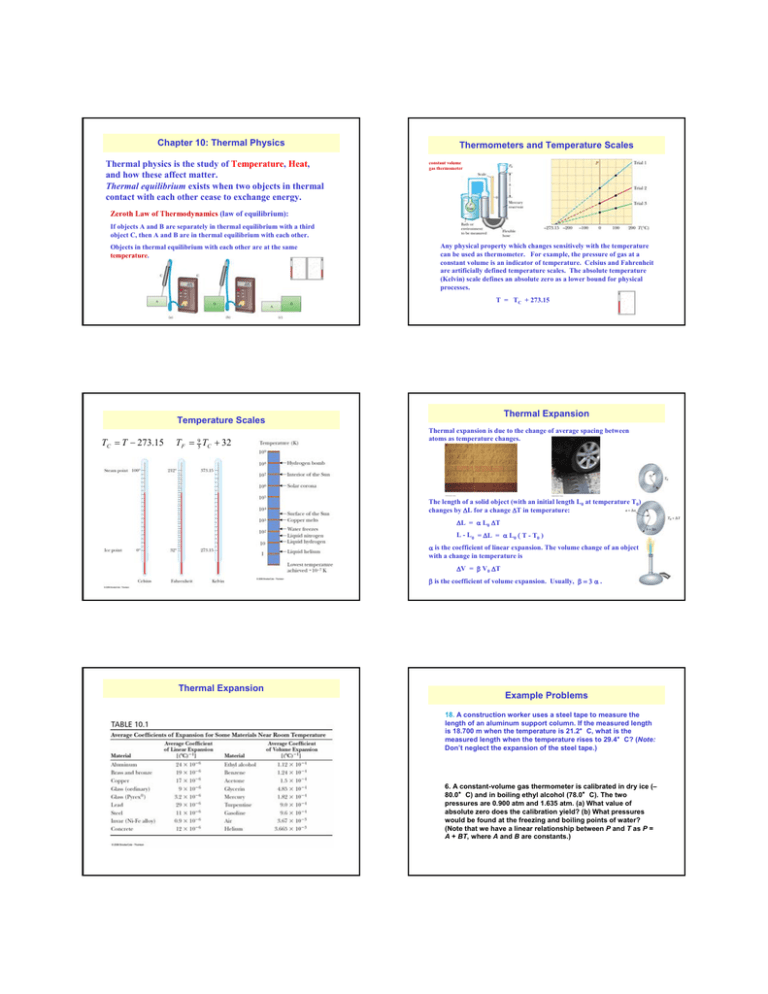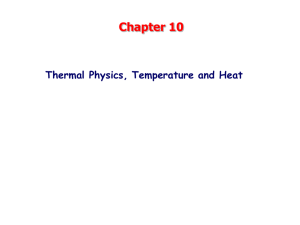Chapter 10: Thermal Physics Thermometers and Temperature Scales ,
advertisement

Chapter 10: Thermal Physics Thermal physics is the study of Temperature, Heat, and how these affect matter. Thermal equilibrium exists when two objects in thermal contact with each other cease to exchange energy. Thermometers and Temperature Scales constant volume gas thermometer Zeroth Law of Thermodynamics (law of equilibrium): If objects A and B are separately in thermal equilibrium with a third object C, then A and B are in thermal equilibrium with each other. Objects in thermal equilibrium with each other are at the same temperature. Any physical property which changes sensitively with the temperature can be used as thermometer. For example, the pressure of gas at a constant volume is an indicator of temperature. Celsius and Fahrenheit are artificially defined temperature scales. The absolute temperature (Kelvin) scale defines an absolute zero as a lower bound for physical processes. T = TC + 273.15 Thermal Expansion Temperature Scales TC = T − 273.15 TF = 95 TC + 32 Thermal expansion is due to the change of average spacing between atoms as temperature changes. The length of a solid object (with an initial length L0 at temperature T0) changes by ΔL for a change ΔT in temperature: ΔL = α L0 ΔT L - L0 = ΔL = α L0 ( T - T0 ) α is the coefficient of linear expansion. The volume change of an object with a change in temperature is ΔV = β V0 ΔT β is the coefficient of volume expansion. Usually, β = 3 α . Thermal Expansion Example Problems 18. A construction worker uses a steel tape to measure the length of an aluminum support column. If the measured length is 18.700 m when the temperature is 21.2°C, what is the measured length when the temperature rises to 29.4°C? (Note: Don’t neglect the expansion of the steel tape.) 6. A constant-volume gas thermometer is calibrated in dry ice (– 80.0°C) and in boiling ethyl alcohol (78.0°C). The two pressures are 0.900 atm and 1.635 atm. (a) What value of absolute zero does the calibration yield? (b) What pressures would be found at the freezing and boiling points of water? (Note that we have a linear relationship between P and T as P = A + BT, where A and B are constants.) Macroscopic Description of An Ideal Gas Macroscopic Description of An Ideal Gas PV = nRT One mole of any substance contains as many particles as there are atoms in 12 g of the carbon-12 isotope. (Avogadro’s number NA = 6.02 x 1023) An ideal gas is a collection of atoms or molecules that move randomly, exert no long-range forces on one another, and occupy a negligible fraction of the volume of their container. For any ideal gas: The volume occupied by 1 mole of any gas at atmospheric pressure and at 0oC is 22.4 L. (Equal volumes of gas at the same temperature and pressure contain the same number of molecules.) R = NA kB PV = nRT = N kBT PV = nRT , where n is the number of moles, T is the absolute temperature, the universal gas constant R = 8.31 J/mol-K = 0.0821 L*atm / mol-K N: number of molecules; kB: Boltzmann’s constant k B = R / N A = 1.38 × 10 −23 J / K The Kinetic Theory of Gases Assumptions: 1. The number of molecules in the gas is large. However, the average separation of molecules is large compared with their dimensions. 2. The molecules obey Newton’s law of motion, but as a whole they move randomly. 3. Molecules interact only through short-range forces during elastic collisions. 4. The molecules make elastic collisions with the walls. The Kinetic Theory of Gases Assume N molecules of an ideal gas are inside a cubic container of volume V (d3=V). Let’s figure out the impulse exerted by one particular molecule in one collision with the wall at x=d. Δp x = mv x − (− mv x ) = 2 mv x How often does this molecule collide with this wall? Δt = 2 d / v x In unit time, the total impulse received by the wall from this molecule is Δp x 2mv x = = mv x2 / d Δt 2d / v x 5. All molecules in the gas are identical. In unit time, the total impulse received by the wall from ALL THE MOLECULES is Nm v x2 / d The Kinetic Theory of Gases The average force received by the wall from the molecules is F= I = Nm v x2 / d Δt 1 3 3 KEtotal = N ( m v 2 ) = Nk BT = nRT 2 2 2 F Nm v x2 / d N P= = = m v x2 A d2 V Because space is isotropic, PV = v x2 = v z2 = v y2 = 13 v 2 2 1 N ( mv2 ) 3 2 U= 3 nRT 2 vrms = 3 kB T = m 3 RT M Maxwell velocity distribution N2 ⎛ m ⎞ ⎟⎟ f (v) = 4π ⎜⎜ ⎝ 2πk BT ⎠ But we also know that PV=NkBT. Therefore, 1 3 m v 2 = k BT 2 2 Molecular Interpretation of Temperature 1 3 m v 2 = k BT 2 2 Temperature is a measure of average molecular speed 3/ 2 v 2e − mv 2 2 k BT For hydrogen molecules at RT, the rms velocity ~ 1.9 km/s! vesc = 2GM E ≈ 11.2 km / s RE Problems 50. A vertical cylinder of crosssectional area 0.050 m2 is fitted with a tight-fitting, frictionless piston of mass 5.0 kg (Fig. P10.50). If there is 3.0 mol of an ideal gas in the cylinder at 500 K, determine the height h at which the piston will be in equilibrium under its own weight. 60. Two small containers of equal volume, 100 cm3, each contain helium gas at 0°C and 1.00 atm pressure. The two containers are joined by a small open tube of negligible volume, allowing gas to flow from one container to the other. What common pressure will exist in the two containers if the temperature of one container is raised to 100°C while the other container is kept at 0°C? Chapter 10 Summary Zeroth law of thermodynamics. Temperature scales Thermal expansion Ideal gas Average (translational) kinetic energy per molecule: proportional to T






